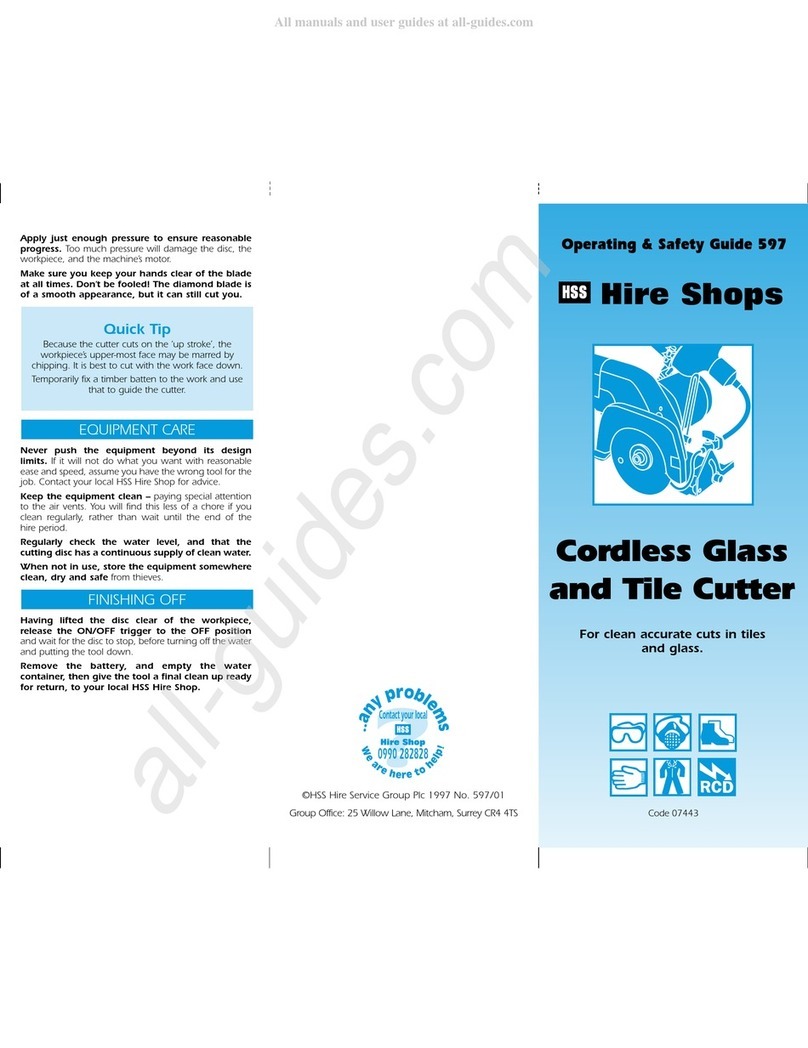For advice on the safety and suitability of this
equipment contact your local HSS Hire Shop.
Keep children, animals and bystanders away from
the work area.
Never use this equipment if you are ill, feeling
tired, or under the influence of alcohol or drugs.
This equipment should only be used by a
competent person who has read and understood
these instructions.
Safety Goggles MUST be worn by everyone in
the work area.
Some materials when cut contain substances
which, when inhaled, can be harmful to
health. A suitable mask must be worn when using
this equipment.
This equipment generates potentially harmful
noise levels. To comply with health and safety at
work regulations, ear defenders must be worn by
everyone in the vicinity.
Wear practical, protective clothing,
gloves and footwear. Avoid loose garments
and jewellery that could catch in moving parts, tie back
long hair.
Always unplug the tool before carrying it or
making adjustments to it.
Having switched OFF the tool, always wait for the
blade to come to rest before putting it down.
NEVER start the cutter with the blade in contact
with the workpiece.
Check the condition of the equipment before use.
If it shows signs of damage or excessive wear, return it to
your local HSS Hire Shop.
Ensure the work area is well lit and ventilated. Do
not work near flammable gases or liquids.
Always switch OFF and unplug the equipment
when not in use. Never leave it switched ON and
unattended.
Never carry or pull the equipment by its flex.
Never use the cutter without the dust collection
bag, or powered dust extraction unit fitted.
Take special care when cutting into walls or floors,
they may contain hidden pipework or electrical
cables. If in doubt, hire a metal locator, to determine the
exact position of such hazards.
Never remove or otherwise interfere with any
safety guards fitted to the cutter.
Never use the cutter to cut asbestos sheeting,
which may yield hazardous dust.
GENERAL SAFETY
Most HSS dustless cutters plug into a standard
13amp power socket. However, 110V models (with
a round yellow plug) must be provided with a
suitable 110V generated supply, or powered from the
mains via a suitable 110V transformer.
If the equipment fails, or if its flex or plug gets
damaged, return it. Never try to repair it yourself.
Keep flexes out of harm’s way, and clear of the
work area.
Extension leads should be fully unwound and
loosely coiled, away from the equipment. Never run
them through water, over sharp edges or where
they could trip someone.
Using electrical equipment in very damp or wet
conditions can be dangerous.
To reduce the risk of electric shock, use a
suitable RCD (Residual Current-Operated Device)
available from your local HSS Hire Shop, or power
the equipment from a mains circuit with a built-in RCD.
This equipment is fitted with an overload protector
and will activate if heavy work is prolonged. If the
protector button pops out and the cutter stops,
release the ON/OFF Trigger and remove the cutter
from the work. Wait 20-30 seconds before
pressing the restart button to resume operation.
Ensure the cutter and power socket are switched
OFF before plugging into the power supply.
Adjust the depth of cut so that the blade protrudes
beyond the base plate by the amount required. Loosen
the depth adjustment wing nut, hold the sole plate
GETTING STARTED
ELECTRICAL SAFETY in one hand, then raise or lower the motor unit as
required before re-tightening.
Confirm that the dust collection bag is empty and
correctly fitted. If it requires emptying, turn the collar a
1/4 of a turn anti-clockwise and remove the bag, (fitting
is the reverse). To empty the bag slide the clip off,
discharge the contents and refit the clip.
To switch the cutter ON, squeeze the ON/OFF trigger.
To switch OFF simply release the ON/OFF trigger.
All that now remains is to plug the cutter into its
power supply and switch ON.
If cutting into a loose piece of work, use a vice or
clamps to hold the work steady and reduce vibration.
At the same time, ensure nothing will get in the
saw’s way and that off-cuts are supported so they
cannot trap the saw blade.
Adopt a stable stance that gives a good view of
the off-cut while keeping you clear of the blade. In
particular, avoid placing your leg and fingers directly
under the cut.
If cutting into a wall or floor at mid point, a plunge
cut will be required. Ensure the blade is clear of the
work and that you have a firm hold of the cutter as the
blade makes contact with the work.
If possible, drape the tool’s flex over one shoulder to
keep it clear of the blade, but make sure there is still
enough slack for you to reach the end of the workpiece
without any difficulty.
Before switching ON, rest the front of the sole-
plate on the work and align the notch on the front
of the sole-plate with any guide mark.
Always start the cutter and let it get up to speed
before bringing the disc into contact with the work.
BASIC TECHNIQUES
ON / OFF
Trigger
Overload
Soleplate
Depth
Adjustment
Wing Nut





















